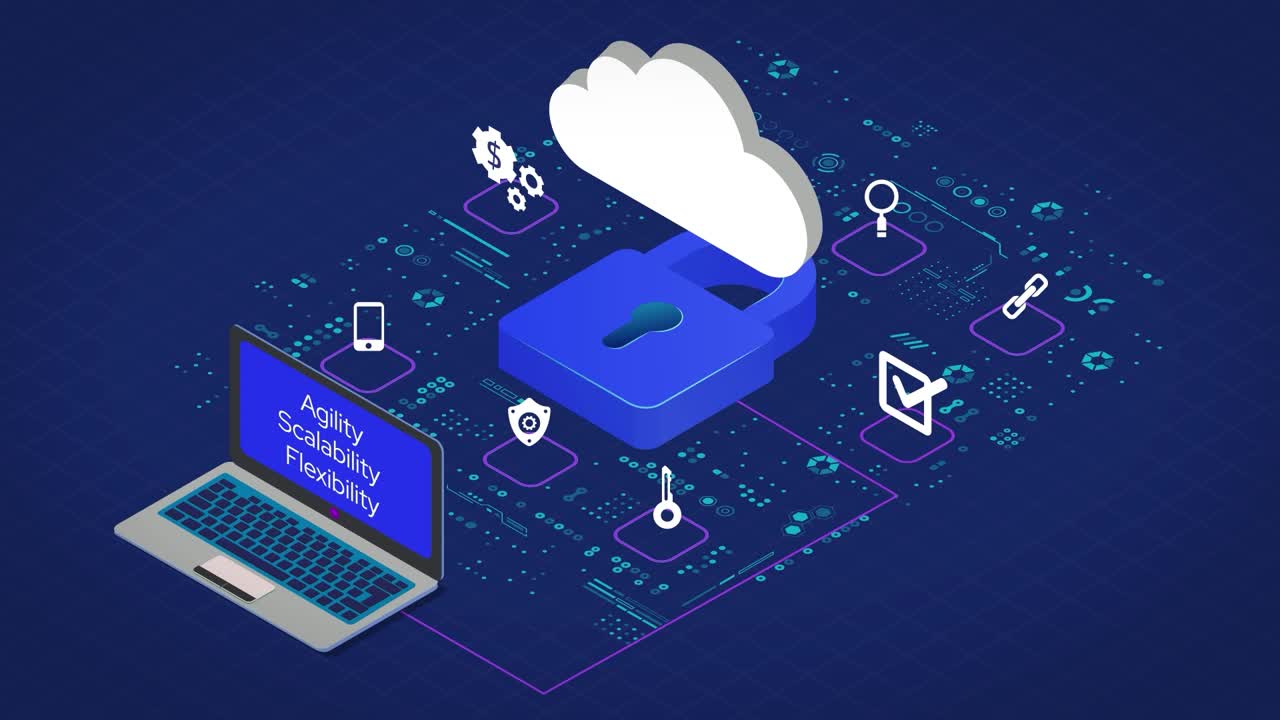Cloud data protection: Ensuring security in the digital era
In today's interconnected world, businesses and individuals rely heavily on cloud computing to store and access their data. The convenience and scalability of cloud services has revolutionized how we manage information. However, with this increased reliance on cloud technology, protecting your cloud data cannot be overstated. This blog will explore the concept of cloud data protection, the significance of safeguarding your data, common security threats, and various solutions and best practices to ensure the security of your valuable information.

What is cloud data protection?
Cloud data or cloud access protection refers to the set of measures and practices aimed at safeguarding data stored in the cloud against unauthorized access, data breaches, loss, or corruption. It encompasses a range of security strategies and technologies designed to ensure the confidentiality, integrity, and availability of cloud-based data. For more general information on what is data protection read here!
The importance of protecting your cloud data
Ensuring the security of your cloud data is of utmost importance, as it contains sensitive information that, if accessed by unauthorized individuals, can lead to severe consequences. Protecting your data can help you avoid breaches, identity theft, and financial loss. Additionally, safeguarding your data can give you peace of mind and foster trust between your cloud providers, you and your clients.
- Data security: Cloud data often contains information, such as personal data stored, intellectual property, financial records, and trade secrets. Failing to protect this data can lead to severe consequences, including financial loss, reputational damage, and legal liabilities.
- Regulatory compliance: Various industry regulations and data protection laws, such as the General Data Protection Regulation (GDPR) and the California Consumer Privacy Act (CCPA), require organizations to implement adequate security measures to protect personal data. Non-compliance can result in significant penalties and legal consequences.
- Business continuity: Data plays a critical role in the day-to-day operations of businesses. A security breach can disrupt operations, leading to downtime, financial loss, and diminished customer trust. Protecting your data ensures business continuity and minimizes the impact of potential threats.
Common cloud data security threats
To effectively protect your cloud data, it is essential to understand the common security threats that can compromise secure data, its integrity and confidentiality. Here are five major threats to be aware of:
- Unauthorized access: Cybercriminals may attempt to gain unauthorized access to your cloud infrastructure or user accounts through phishing, password attacks, or exploiting vulnerabilities. Once inside, they can steal or manipulate sensitive data.
- Data breaches: Breaches can occur for various reasons, including weak authentication mechanisms, unpatched vulnerabilities, or insider threats. A data breach can result in the exposure of sensitive data, leading to reputational damage and financial loss.
- Data loss: Data loss can result from accidental deletion, hardware failure, natural disasters, or malicious activities. Without proper cloud backup and recovery plans, critical data may be irretrievably lost.
- Malware and ransomware: Malicious software can infect cloud systems, encrypt data, or steal sensitive information. Ransomware attacks, in particular, can hold your data hostage until a ransom is paid, causing significant disruption to your operations.
- Insider threats: Internal employees or contractors with access to your cloud infrastructure can misuse or leak sensitive data intentionally or inadvertently, posing a significant risk to your data security.
Different solutions for how to protect cloud data
When it comes to protecting your cloud data, it's important to implement a range of strategies to ensure that your information is safe from unauthorized access, data breaches, and other security threats. Fortunately, there are several solutions and best practices to mitigate the risks and protect your cloud data effectively. Here are some key strategies.
Implementing access control measures for cloud data
- Role-Based Access Control (RBAC): RBAC ensures that users have access only to the resources necessary to perform their job functions. You can control and limit access to your cloud data by assigning specific roles and permissions.
- Identity and Access Management (IAM): IAM solutions provide centralized control over user identities and access rights. It enables organizations to manage user provisioning, authentication, and access policies, reducing the risk of unauthorized access.
- Multi-Factor Authentication (MFA): MFA adds an extra layer of security by requiring users to provide multiple forms of authentication, such as a password, SMS code, or biometric verification. This significantly reduces the risk of unauthorized access, even if passwords are compromised.
Regularly monitoring and auditing cloud data access
- Log management and analysis: Implementing robust logging mechanisms allows you to track and analyze user activities, system events, and potential security incidents. Monitoring logs helps detect suspicious behavior, unauthorized access attempts, and potential data breaches.
- Audit and compliance reports: Generating audit reports regularly provides insights into the security posture of your cloud infrastructure. These reports help identify vulnerabilities, ensure regulation compliance, and demonstrate security practices to auditors and stakeholders.
Securing cloud data stored with backup and recovery plans
- Automated cloud data backup: Regularly backing up your cloud data ensures that you have a copy of your information in case of accidental deletion, data corruption, or system failures. Automating the backup process reduces the risk of human error and ensures the availability of up-to-date backups.
- Disaster recovery strategies: Implementing a comprehensive disaster recovery plan allows you to recover your cloud infrastructure and data in a catastrophic event. This includes backup replication to geographically separate locations and testing the recovery procedures periodically.
Data Loss Prevention (DLP) solutions for cloud services
- How DLP works: DLP solutions identify, monitor, and protect sensitive data from unauthorized disclosure or exfiltration. DLP tools can detect and prevent data breaches or policy violations by analyzing data patterns, content, and context.
- DLP policies and rules: Defining and enforcing DLP policies and regulations helps classify sensitive data, control its access and usage, and prevent data leakage. Policies can include scanning for personally identifiable information (PII), credit card numbers, or intellectual property and applying appropriate actions when violations occur.
- Selecting the right DLP solution: Choosing the appropriate one requires evaluating factors such as scalability, integration capabilities, ease of use, and compatibility with your cloud service provider. Experienced security professionals can help select and implement the most suitable solution.
Cloud data protection best practices
To ensure the utmost protection of your cloud data, it is important to follow certain best practices. In addition to implementing the solutions mentioned above, there are several other steps you can take to enhance your own cloud storage and data protection.
- Regular security awareness training: Educating employees about security best practices, the risks associated with cloud computing, and identifying and responding to potential threats is crucial in building a security-conscious culture within your organization. This can include attending training sessions and staying up to date on the latest trends and threats in the cybersecurity world.
- Consistently review and update security policies: Regularly reviewing and updating security policies ensures that they align with the evolving threat landscape and industry regulations. This can include conducting periodic risk assessments and addressing any identified vulnerabilities promptly, implementing multi-factor authentication, enforcing strong password policies, and keeping your antivirus and firewall software up to date. By doing so, you can further safeguard your cloud data from potential cyber threats.
- Continuous risk assessment and vulnerability management: Implementing a robust risk assessment and vulnerability management program helps identify and remediate potential weaknesses in your cloud infrastructure. Regular vulnerability scans and penetration testing can uncover vulnerabilities before they are exploited. This can be achieved through the use of logging and auditing tools, which can help identify any potential security breaches before they become major issues.
Choosing a cloud service provider
Knowing how to protect cloud data requires a multi-layered approach involving a combination of technical solutions, best practices, and a strong security mindset. Remember to select a reputable cloud services provider and maintain regular security audits and assessments to ensure the effectiveness of your data protection strategies. Look for a comprehensive approach to cloud data protection, including some of the security protocols listed below.
- Encrypting cloud data: Encryption is a fundamental security measure to protect your cloud data. By encrypting your data at rest and in transit, you add an extra layer of protection against unauthorized access. Encryption algorithms scramble the data, making it unreadable without the decryption key. When selecting a cloud service provider, ensure that they offer robust encryption capabilities and that you have control over the encryption keys.
- Network security: Securing your cloud data involves not only protecting the data itself but also the complex network infrastructure that facilitates its storage and transmission. Implementing network security measures such as firewalls, intrusion detection and prevention systems, and virtual private networks (VPNs) helps safeguard your cloud environment from external threats. These measures establish secure communication channels and prevent unauthorized access to your cloud infrastructure.
- Cloud provider security: When selecting a cloud service provider, it is crucial to assess their security practices and capabilities. Look for providers that prioritize security and have robust security certifications and compliance frameworks in place. Conduct due diligence to understand their data protection measures, incident response protocols, and backup and recovery capabilities. A reputable provider will have transparent security policies and procedures, and they should be able to address any security concerns you may have.
- Data segregation and isolation: Cloud services providers host data from multiple customers on shared infrastructure. To ensure the privacy and security of your data, it is essential to have strong data segregation and isolation mechanisms in place. Providers should employ robust access controls and separation protocols to prevent unauthorized access or data leakage between different customer environments. Additionally, data encryption can further enhance data isolation and protect against unauthorized access within the cloud infrastructure.
Let Flexential protect you and your cloud data
Protecting your cloud data is paramount in today's digital age. By understanding the concept of cloud data protection, recognizing common security threats, and implementing robust solutions and best practices, you can minimize the risks and ensure the security and integrity of your valuable data. With the proper measures to protect data already in place, you can confidently embrace the benefits of cloud computing while keeping your information safe from potential harm.
At Flexential, we understand the importance of protecting your cloud data in an ever-evolving threat landscape. Our comprehensive cloud security solutions and expertise can help safeguard your valuable information. With state-of-the-art security measures, including encryption, access controls, threat monitoring, and disaster recovery capabilities, we ensure the highest level of protection for accessing data from your cloud-based assets.








